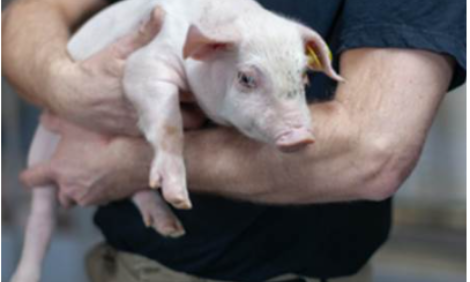



Methods for Inactivating PEDV in Hog Trailers
A summary of four studies conducted between September 2013 and July 2014 to evaluate the efficacy of different aspects of commonly used trailer sanitation protocols for inactivating porcine epidemic diarrhoea virus (PEDV).The same experimental model was used in all four of these studies at Iowa State University and made available by Pork Checkoff.
A fixed volume (5 or 10ml) of undiluted PEDV-positive faeces from pigs intentionally infected with PEDV (or negative faeces for the negative control group) was spread evenly on the floor of a six- by six-inch aluminium tray with one-inch sides.
The trays were made to replicate the floor of a livestock trailer. Following treatment as outlined in Tables 1 to 4 for each study, the faeces was re-collected from the trays, and given to PEDV-naïve four-week old pigs via gastric tube. These pigs served as a bioassay to detect the presence of infectious PEDV remaining in the treated faeces. Faecal swabs were collected from the pigs on days 3 and 7 post-challenge. The faecal swabs were tested for the presence of PEDV by PCR to determine if the pigs were infected by the material in each tray.
Each treatment group contained four replicates (four trays and four pigs; one tray per pig). All four pigs in a treatment group were housed separately in raised tubs but in the same room.
Study 1 evaluated time and temperature combinations required to inactivate PEDV in faeces.
Treatment groups evaluated and the bioassay results are in Table 1.
| Table 1. Description of treatment groups and bioassay outcomes for Study 1 | ||
| Treatment group | Description of treatment | Percentage of PEDV positives (out of 4) |
|---|---|---|
| Negative control | No treatment, pigs received a gavage of PEDV-negative faeces |
0% (0/4) a |
| Positive control | No treatment, pigs received a gavage of PEDV-positive faeces |
100% (4/4) b |
| 71C-10M | PEDV-positive heated to 71°C (160°F) in an incubator and held at this temperature for 10 minutes |
0% (0/4) a |
| 63C-10M | PEDV-positive faeces heated to 63°C (145°F) in an incubator and held at this temperature for 10 minutes |
25% (1/4) a,b |
| 54C-10M | PEDV-positive faeces heated to 54°C (130°F) in an incubator and held at this temperature for 10 minutes. |
25% (1/4) a, b |
| 38C-12H | PEDV-positive faeces heated to 38°C (100°F) in an incubator and held at this temperature for 12 hours |
50% (2/4) a,b |
| 20C-24H | PEDV-positive faeces left at 20°C (room temperature) for 24 hours |
25% (1/4) a, b |
| 20-C-7D | PEDV-positive faeces left at 20°C (room temperature) for 7 days |
0% (0/4) a |
| Groups with different letters indicate statistically significant differences (P<0.05) | ||
The 71C-10M and 20C-7D treatment groups were each found to be 100 per cent effective at inactivating PEDV. No other groups were found to be effective.
Study 2 evaluated the efficacy of Stalosan® F disinfectant powder to inactivate PEDV in faeces.
Treatment groups evaluated and the bioassay results are in Table 2.
| Table 2. Description of treatment groups and bioassay outcomes for Study 2 | ||
| Treatment group | Description of treatments | Percentage of PEDV positives (out of 8) |
|---|---|---|
| Negative control | PEDV-negative faeces, no Stalosan F contact |
0% (0/8) a |
| Positive control | PEDV-positive faeces, no Stalosan F contact |
100% (8/8) b |
| Stalosan F treatment | PEDV-positive faeces, one hour of Stalosan F contact |
100% (8/8) b |
| Groups with different letters indicate statistically significant differences (P<0.05) | ||
The Stalosan® F treatment was not effective at inactivating PEDV.
Study 3 evaluated the efficacy of Accel® disinfectant to inactivate PEDV in faeces. Treatment groups evaluated and the bioassay results are in Table 3.
| Table 3. Description of treatment groups and bioassay outcomes for Study 3 | ||
| Treatment group | Description of treatments | Percentage of PEDV positives (out of 4) |
|---|---|---|
| Negative control | No treatment, pigs received a gavage of PEDV-negative faeces |
0% (0/4) a |
| Positive control | No treatment, pigs received a gavage of PEDV-positive faeces |
100% (4/4) b |
| 5mL-1:16 | A 1:16 concentration of Accel disinfectant was applied to 5ml of PEDV-positive faeces for 30 minutes |
0% (0/4) a |
| 10mL-1:16 | A 1:16 concentration of Accel disinfectant was applied to 10ml of PEDV-positive faeces for 30 minutes |
0% (0/4) a |
| 5mL-1:32 | A 1:32 concentration of Accel disinfectant was applied to 5ml of PEDV-positive faeces for 30 minutes |
0% (0/4) a |
| 10mL1:32 | A 1:32 concentration of Accel disinfectant was applied to 10ml of PEDV-positive faeces for 30 minutes |
0% (0/4) a |
| Transmission control | ¼ pigs in the group was gavaged with PEDV-positive faeces, ¾ were gavaged with PEDV-negative feces |
25% (1/4) |
| Groups with different letters indicate statistically significant differences (P<0.05). Results from the transmission control group were not included in statistical analysis. |
||
All Accel treatment groups (5mL-1:16, 5mL-1:32, 10mL-1:16 and 10mL-1:32) were 100 per cent effective at inactivating PEDV.
The transmission control group was included to validate that the animal housing and handling protocols used for the bioassay were preventing transmission of virus from one pig to another within the same treatment group. Within the transmission control group, the one positive pig did not transmit PEDV to the three negative pigs during the duration of the trial.
Study 4 evaluated multiple trailer sanitation protocols that included wash, disinfection with Synergize® and TADD steps.
Treatment groups evaluated and the bioassay results are in Table 4.
| Table 4. Description of treatment groups and bioassay outcomes for Study 4 | ||
| Treatment group | Description of treatments | Percentage of PEDV positives (out of 4) |
|---|---|---|
| Negative control | No treatment, pigs received a gavage of PEDV-negative faeces |
0% (0/4) a |
| Positive control | No treatment, pigs received a gavage of PEDV-positive faeces |
100% (4/4) b |
| WD-68C-10 | PEDV-positive faeces power washed with detergent, application of 1:256 concentration of Synergize disinfectant for 10 minutes, heated to 68°C (155°F) in an incubator and held at this temperature for 10 minutes |
0% (0/4) a |
| WD-66C-10 | PEDV-positive faeces power washed with detergent, application of 1:256 concentration of Synergize disinfectant for 10 minutes, heated to 66°C (150°F) in an incubator and held at this temperature for 10 minutes |
0% (0/4) a |
| WD-60C-20 | PEDV-positive faeces power washed with detergent, application of 1:256 concentration of Synergize disinfectant for 10 minutes, heated to 60°C (140°F) in an incubator and held at this temperature for 20 minutes |
0% (0/4) a |
| WD-49C-20 | PEDV-positive faeces power washed with detergent, application of 1:256 concentration of Synergize disinfectant for 10 minutes, heated to 49°C (120°F) in an incubator and held at this temperature for 20 minutes |
0% (0/4) a |
| WD-20C-12 | PEDV-positive faeces power washed with detergent, application of 1:256 concentration of Synergize disinfectant for 10 minutes, left at 20°C (room temperature) for 12 hours |
0% (0/4) a |
| WD60 | PEDV-positive faeces power washed with detergent, application of 1:256 concentration of Synergize disinfectant for 60 minutes |
0% (0/4) a |
| WD10 | PEDV-positive faeces power washed with detergent, application of 1:256 concentration of Synergize disinfectant for 10 minutes |
0% (0/4) a |
| Groups with different letters indicate statistically significant differences (P<0.05). | ||
All treatment groups (WD-68C-10, WD-66C-10, WD-60C-20, WD-49C-20, WD-20C-12, WD60, WD10) were 100 per cent effective at inactivating PEDV.
Discussion and Implications
PEDV in the presence of faeces was inactivated by heating to 71°C for 10 minutes or by maintaining room temperature (20°C) for at least seven days. No other combinations of time and temperature evaluated were shown to be effective at inactivating PEDV.
Accel disinfectant was effective at inactivating PEDV in the presence of both heavy and light faecal contamination with 30 minutes of contact time at room temperature. Accel was found to effective at both concentrations evaluated (1:16 and 1:32).
Stalosan F disinfectant powder alone with one hour of contact time at room temperature did not inactivate PEDV in faeces.
The results for studies 1 through 3 demonstrate the importance of evaluating proper disinfection choices for different applications. Disinfectants vary widely not only in their spectrum against pathogens and their physical properties. Properties include liquid versus powder and different foaming qualities. While the spectrum of activity is very important, these other properties are also important because they affect the application of the disinfectant and its ability to remain in contact with surfaces.
Complete trailer sanitation protocols that included a wash with detergent, disinfection with Synergize at a concentration of 1:256, and heating were effective at inactivating PEDV.
Synergize alone with 10 or 60 minutes of contact time following a wash with detergent and disinfection was effective with or without heating after disinfection.
The sanitation procedures evaluated in studies 1, 2 and 3 were conducted without removal of faeces. The investigators do not propose that TADD-only or disinfectant-only approaches to trailer sanitation are preferred alternatives to thoroughly washing, disinfecting and drying trailers. Indeed, study 4 demonstrated the value of including washing, disinfecting and TADD in a trailer sanitation protocol. Rather, this work demonstrates the value of possible alternatives when all of the steps cannot be accomplished as a means to reduce the risk of transmitting PEDV between groups of animals during transport.
February 2015








